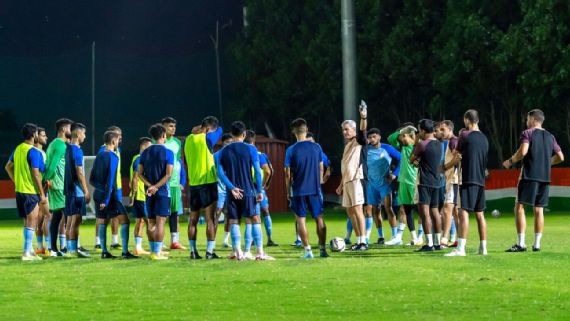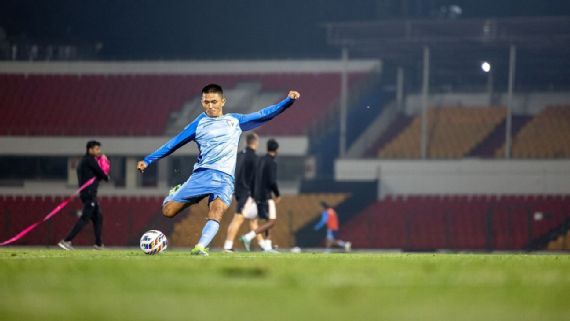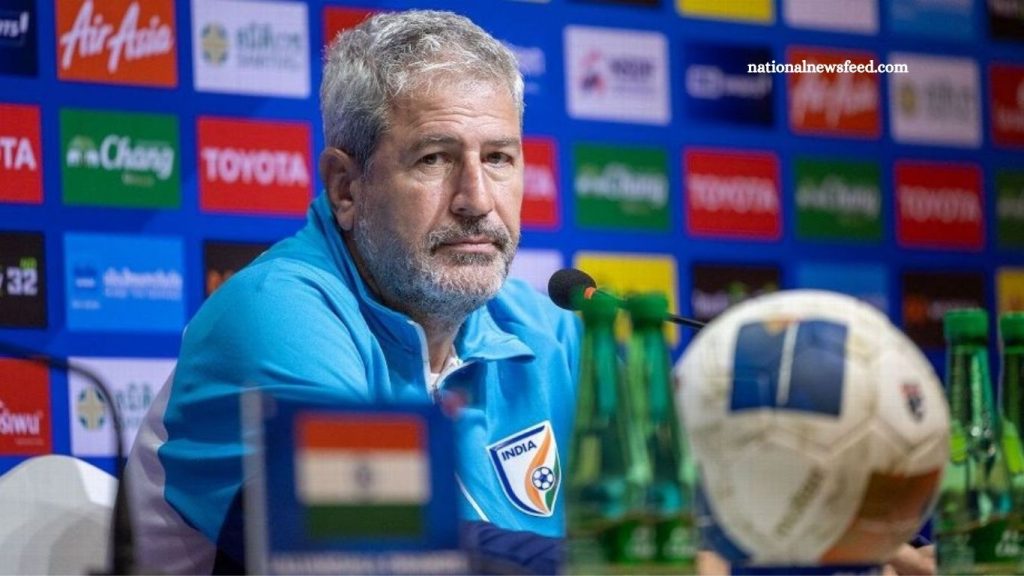Manolo Marquez’s departure from the Indian men’s national football team comes less than a year after his appointment, leaving behind more questions than answers. During his brief stint, he simultaneously managed FC Goa for the entirety of the domestic season—an unprecedented dual responsibility that, in hindsight, served neither team well.
While FC Goa bagged a trophy under his leadership, the national side managed just one win in eight outings. The fallout has left Indian football fans frustrated, and rightly so.
A Conflict of Commitment: Club vs Country
When Marquez was appointed as India’s head coach, he had already committed to managing FC Goa in the Indian Super League (ISL). Rather than stepping away from one role, he held on to both, a move that now seems ill-advised at best, negligent at worst.
His dual-role experiment stretched him thin. National team duties were sidelined as club football naturally demanded day-to-day attention. Unfortunately, the AIFF not only allowed this setup but facilitated it, raising concerns about its decision-making framework.
Read More: Democratic Hopefuls Aim to Tie Vance to Controversial 2028 Megabill
Lack of Planning by AIFF
The All India Football Federation (AIFF) deserves serious scrutiny for the decision to allow a coach to hold two full-time, high-pressure jobs. The federation failed to enforce proper planning and process when it mattered most.
The move showed a lack of vision for Indian football’s long-term interests. It also exposed AIFF’s tendency to react, rather than plan strategically. In doing so, they placed national football at the mercy of divided attention and burnt-out leadership.

Marquez’s Tactical Missteps
Although the dual role was a mistake, Marquez must also shoulder the blame for tactical inconsistencies. Despite his vast experience of over three decades in coaching, he often appeared indecisive in national team matches.
Formation Fluctuations
India oscillated between 3-5-2, 4-4-2, and 4-3-3 formations, leading to tactical confusion among players. No consistency meant no cohesion on the pitch.
Selection Surprises

Marquez made several puzzling choices. Dropping midfield mainstay Suresh Singh Wangjam for the crucial match against Bangladesh baffled many, as did starting Ashique Kuruniyan as a central striker—a role far from his natural position.
The Sunil Chhetri Conundrum
Sunil Chhetri’s status was always going to be a sensitive subject. Initially, Marquez seemed to look ahead, giving opportunities to younger forwards like Farukh Choudhary and Irfan Yadwad during friendlies.
However, come the AFC Asian Cup qualifiers, he reverted to Chhetri—tasking the veteran with roles he could no longer effectively perform solo. The strategy backfired, and Chhetri was benched again in the very next game. The lack of a defined forward strategy underscored the chaos in Marquez’s short tenure.
A Year of Regression
India’s performance under Marquez can be summed up in bleak statistics:
- 8 games played
- 1 win (against Maldives in a friendly)
- 5 losses
Only 3 games with goals scored
This performance has left India in a worse position than before Marquez’s appointment. At this point, even qualifying for the AFC Asian Cup 2027 is uncertain—a stark contrast to the momentum built in previous years.
Was This Avoidable?
Absolutely. Both Marquez and AIFF knew the challenges. Marquez had years of experience in Indian football, managing Hyderabad FC and Goa, and was fully aware of the demands. Choosing to accept the national role without stepping away from club duties was a personal miscalculation that cost India dearly.
The AIFF, on the other hand, failed to implement safeguards, vet alternatives, or consider long-term implications.
Lessons for Indian Football
Clear role separation is crucial: No coach should be allowed to manage a club and a national team simultaneously.
- Consistent tactical planning is key for national success.
- The AIFF must prioritize accountability and structure in hiring processes.
- India needs a full-time national coach focused solely on international football.
Frequently Asked Questions
Why did Manolo Marquez leave the Indian national football team?
He stepped down due to poor results and an unsustainable dual role managing both the Indian national team and FC Goa.
How long was Marquez in charge of India?
Less than a year—he was appointed in mid-2024 and left in mid-2025.
Did Marquez achieve anything with India?
Unfortunately, no major achievements. The team won only one out of eight matches under his leadership.
Was it allowed for him to coach both club and country simultaneously?
Yes, the AIFF allowed it, but it turned out to be a poor decision in retrospect.
What was his record with FC Goa during this period?
He led FC Goa to a domestic trophy and maintained strong performances throughout the ISL season.
Who will replace Manolo Marquez as India’s coach?
As of now, AIFF has not announced a replacement. The appointment process is reportedly ongoing.
What does this mean for India’s AFC Asian Cup 2027 qualification?
India’s chances are now in serious jeopardy. A new coach must stabilize the team quickly.
Could this situation have been avoided?
Yes. With better foresight and governance from AIFF and a more realistic self-assessment from Marquez, this dual-role failure could have been avoided.
Conclusion
The Marquez experiment should serve as a wake-up call for Indian football. Dividing a coach’s attention between club and country was a strategic blunder that led to wasted opportunities and declining national performance.
Both Manolo Marquez and the AIFF must take accountability. Marquez’s tenure, filled with tactical missteps, poor planning, and inconsistent results, has set the national team back at a crucial time.
Moving forward, the AIFF must prioritize full-time coaching appointments, insist on role exclusivity, and ensure that the head coach is empowered, dedicated, and properly supported.

